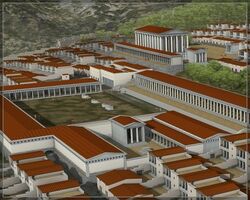
Priene -- from A Walk Through Ancient Priene (from FHW).
Phaeselis is a large city of thirty thousand people, instead of being larger due to the rate of infant mortality and other factors. When Alexander founded the city on the razed ruins of Phoenicia, he called it Phaeselis after Phasela -- his younger sister, and then founded Alexandria on the Phoenix as a garrison. The city was named in her honor.
The tale goes that Phasela had grown up with psychic powers and wasn't at all understood by the common people. One day, as a twelve year old expecting to be married, she was in the market with the Queen Mother. She somehow got separated from the Queen and she was slain by a wizard with magic. Just for having psychic powers. Alexander loved Phasela, and vowed to honor her memory. When the city of Phoenix was conquered and razed to the ground, Alexander founded a city where psychics and psychically capable could live in peace and without fear or persecution. He named the city, Phaeselis.
Phaeselis itself is built over the razed ruins of Phoenicia. The city of Phoenicia is subsequently built on layers of of more ancient cities and has two mounds were ancient cities were built surrounding it. The tels -- Tel Dan and Tel Aine Gazal are labyrinths of ancient cities and treasures. The place holds secrets, secrets beyond imagining. Some around, and some below. All of these make up the "Dungeon" of Phaeselis. If the rumors are correct, the following is true about the tels and the dungeon below:
- The sewer system of the city.
- The labyrinth ruins of Dan and Aine Gazal.
- the remains of the ancient city.
- The remains of still older city than the first.
- An abandoned dwarven settlement on the otherside of the river called Dwarvenholme.
- And caverns that plunge to even deeper depths.
Phaeselis does control the river delta, it's six miles up river, but the river is deep enough to provide ocean going vessels two harbors. The climate is Mediterranean, a little mild, and the land is fertile. The river is fresh and sweet, although most people get their drinking water from the pristine, smaller waterfalls on either side of the city. Phaeselis is also a terminal for the Silk Road and the Spice Route. And mostly because that Phaeselis is a terminal, there is a cosmopolitan aspect of the city. The city mostly governs itself with little influence from the larger nation of Anaxamandras, which surrounds the city and it's 50 mile environment.
Rulership[]
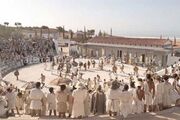
The assembly.
The City is originally envisioned to be ruled by a oligarchic council of Psions, a psychic oligarchy of 9 people, and an assembly of the common people. The oligarchy decides how to enforce public and economic policy; while the Assembly makes the laws. Balancing both the Oligarchy and the Assembly is the Council of Nobles. Made up of eleven individuals, they discuss the nature of the rich and powerful in the city.
It was set up this way by Alexander because he felt that a true Democracy would not serve the Psionic majority. However, political forces that were not psychic has made inroads and now controls 4 ninths of the council. The moneychangers infiltrated the psionic oligarchy and replaced four of the councilors with non-psychic entities; with a non-psionic councilor representing the Guilds in the city (Guilder Archaean), and three Oligarchs representing the interests of the non-psionic rich. So far, the psions haven't risen against the the infiltrated Oligarchy, but some think they are biding their time.
However, it's the Assembly of the People that makes the laws, and the moneychangers have begun to infiltrate that as well. The moneychangers, seeking to control all the wealth, have bought and paid for certain politicians in the assembly with bribes and backing for their election campaigns. The assembly is slowly becoming compromised against the people's wishes. The Assembly is slowly serving the moneychangers' will.
The Authorities and the Law[]
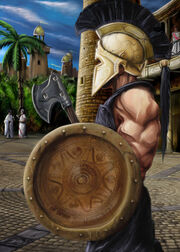
Phalanx by ER Games.
So, to police the streets, the authorities have authorized about 500 city guards, including a few dozen elite individuals. These guards have the power to arrest people who have broken the law to be tried before a magistrate or a judge. The Assembly, however, has the power to judge political crimes against the city (treason, for instance). While some cities have lacklustre law enforcement, the psions of the city have a better time at enforcing the law, though fear of a telepath's ability to read minds often keeps most of the non-gifted uneasy. Fortunately, the Gifted currently out numbers the low vibrating non-gifted. How this will change, its not known in the future. But as long as the fear exists, so to exists the threat of a rebellious non-gifted population.
Nevertheless, the city watch has been well equipped to maintain order in the city. The Authorities and the Law that maintain order are a mix of non-psychics and psychics, and some people capable of casting spells. However, the Authorities have their hands full in maintaining law within the city. This is where the Brotherhood of Dike Astraea comes in to help. A group of athletes that patrol the city streets, they aren't there to show off their muscles or to do battle with monsters. The athletes, who are always unclothed, have taken upon themselves the dour purpose of Apprehending criminals in the city -- even though they are not strictly sanctioned to do so by the Assembly or the Oligarchy. The dourness of their job makes them seem like cynics, but often they are anything but. Many of the watchmen feel that they are vigilantes, but their connection to the female spirit of Justice has made the Assembly recognize them as a religious order.
However, neither the City Watch nor the Brotherhood will equip themselves to do battle with monsters. Nor will they go down into the city's Dungeon. Nor are they likely to help against the powerful noble families in the city, nor the powerful religious groups such as the Zeusian Church or the Hindu Swamis. After all, these groups would hardly ever break any of the city's laws.
The Forces of Light[]
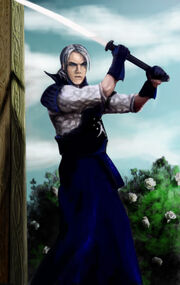
An aasimar by ER Games.
There are organizations of benefience operating within the city, including a few knighthoods. Although in truth, they are close to a knightly order as one can get in Hellenistic culture. The culture celebrates heroes instead of chivalry, so the usual paladin is thought of as a heroic figure with flaws. Such knightly orders include: The Sons of Ares, Athena's Pride, the Kshatriya of Vishnu, the Creator's Hand, and Shiva's Justifiers. Other lesser orders include the Order of the Impregnable Heart, Alexander's Companions, the Paladins of Huang-di, and the Warriors of Brahma. Besides these orders of paladins and warriors, their are angelic beings operating within Phaeselis. These include Aasimars, Half-Celestials, and true Angels. Of these include Seraphs and Cherubs, all trying to defeat the darkness within Phaeselis. And the Darkness can run very deep.
The Dark Side of Phaeselis[]
Like any city, Phaeselis has a dark side. Although envisioned to be a haven for those who particularly psychically gifted or sensitive, evil still exists in the hearts of men. Criminal lords here have organized crime quite effectively. From the Ravana family to the moneychangers to the upstart and so-called king of thieves, Autolycus. These groups often make war with each other, and unlike the other two, the moneychangers have the backing of the Law in the city. The criminals use extortion, gambling, usury (a favorite amongst the moneychangers), and prostitution. Chief amongst these criminal families are the Ravana family, and Autolycus is their deadily rival. However, there are groups called the Hassassins, which are of Ariyan origin and kill for money.
However, there are worse things and people that lurk within Phaeselis. The Necropolis is not only inhabited by grave robbers and the living dead; but by a group of nihilists and disgusting people called the Abandoned. They are called this because the rest of society, including the Church of Hades, regards them as abhorent, sick individuals. Beyond this are the tieflings, half-fiends, and true fiends that operate within the city. These devils and demons make Phaeselis their home. Beyond that, there are psions that represent a true Psionic Threat to the world. As of now, no one can identify the threat.
The People of Phaeselis[]
Phaeselis has become a trading city. Being a terminus of two major routes: the Silk Road and the Spice Route; plus having a port does have it's advantages. About two thirds of the city are humans. With the remaining third -- from the most populous to the least -- being: Olivaen Elves, Massalian Elves, Iron Dwarves, halflings, litorians, Pelagasiri elves, orcs, High elves, and far stranger things -- including lizardmen, ogres, and other strange things.
The Districts of the City[]
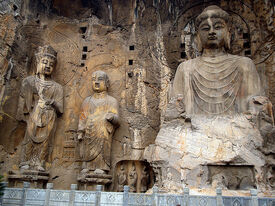
Inspiration for idols carved into a cliff, the longmen grottos (by Alex Kwok, p.d.)
Phaeselis is quadrisected by the Phoenix River and a large cliff or escarpment that is 70 feet high. The river itself splits into five falls. The main falls is a Cateract type fall, that fills a large river basin below. The other four falls are less in intensity. The river's waters eventually rejoin about two miles down stream, where they continue on to the river's delta. Framing the main falls, on the North is a staue of Zeus, carved into the rock face (which is made of dense granite), while on the south side is a statue of the Buddha. This represents the city as a gateway to the East for Westerners or occidentals. While for the orientals, it represents the gateway to the West. Winding up both sides of the statues are two large stairways, also cut into the rock face, and paved with riverstone. Despite this, though, it's hard for merchants from above the city to trade with merchants below the city. So, the two halves have an independent economy almost. What unifies them is a system of pullies and elevators designed by the Hellenes to carry goods up and down the cliffside.
Because of this quadrisection, the city is naturally divided into four quadrants. The northwest Quadrant is commonly inhabited by the Hellenes. While the Southwest Quadrant is commonly inhabited by the Phoenicians. The Southeastern Quadrant is inhabited by Aryavartans, and the Northeastern District is inhabited by the Persian-like Ariyans, with a community of people from the fabled Middle Kingdom of Qin'ae thanks to the Silk Road. Each quadrant has a community elves, although the southwestern quadrant also has a large community of dwarves.
The Docks[]
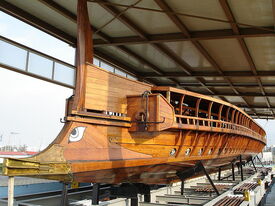
The Olympias . . . a reconstruction of a Trireme. (Templar52.)
The docks are in both the Southwestern and Northwestern quadrants. They are built so that ships can be wrighted and moored before sailing. The docks are built on sturdy river banks with the narrowest point between them being five hundred feet of water. Here, the river is deep enough to support ocean going vessels, like the Sextaremes. Some of the docks and piers are built to float. These floating piers and docks are reserved for personal use and recreational craft. Others are more permanent and are built to support commercial and military interests. So two dozen ships moor here at any given time, including two triremes (the Charybdis and the Revenge) and the city's one Sextareme - the Leviathan.
Like any city of trade using docks, the docks area is full of warehousing, shipyards, taverns and hostels, catered to sailors, merchants, and tourists. People often remark that the docks area is it's own community, however this is not the case as at least five city guards patrol the area at any given time. However, many of the Phaeselese live their whole lives without going into docks. However, many of them haven't been in the noble's quarter, either.
The Hellenic Quarter[]
Just like Jerusalem in our day, the city is divided into Quarters, this time by an action of Geography and Central Planning. The four major human cultures are roughly divided this way by one of Phaeselis' rulers -- actually one of Alexander's Strategos is actually to blame. The Hellenic Quarter is populated by the Hellenes. While Hellenic (an analog to Koine Greek) is the lingua franca of the Empire, it's spoken highly exclusive in the Hellenic Quarter.
The Beautiful Gate is the northern entrance to the city, and it's guarded by carved nude images of Aphrodite and Ares (Love and War). The major neighborhoods are Laughing Brook, the Temple District, the Massalian Elf Enclave, and Moneychanger Row -- which is made up chiefly of Ishtar Street and its environs. Finally there is Old Town, and it's most famous square: Hero Square.
Hero's Square[]
Delvers into the deeps and Heroes that slay monsters within and without the city won't know where they'd be without the merchants of Old Town and Hero's Square. Here, they get resupplied for their ventures into the dark. Squared around a large stairway into the Ancient ruins below, and deeper; Hero's Square provides enchanting and psionic infusion services, a large tavern for the heroes to find sleep and get drunk, and places to buy basic wares like swords, armor, weapons, magical items, and a temple dedicated to Nike; where heroes can get healing.
The large tavern is Hercules' Rest, dedicated to delvers and heroes everywhere. It's also the informal hall of the adventuring company Theseus Heirs, and one could find adventuring jobs posted that are lucrative and dangerous. Across the street is Psyche's Place, another tavern where both psions and wizards can get together. It also a place where people can order custom made magical and psychic items, through an organization that wishes to remain anonymous. There is even a podium nearby where psionic and wizardly philosophers can pontificate to crowds of people. Hercules' Rest is run by Dimmosthenes, while Psyche's Place is ran by a woman named Cimmeranth.
Timmon's Armory is ran by Timmon and his ten apprentices. Here, the bronzecasters make helmets and arms for the various heroes that come to call. No longer do they cater to nobles, as the middle class Adventurer often has the coin to suit their needs. They frequently make the linothorax out of boiled leather (acts as a leather breastplate), but those with the coin and the resources can order the more protective linen linothorax. They take commissions to make bronze breastplates. The most popular of which is the muscled cuirass, which is shaped to fit the hero or heroine. Women heroines, though, often order a leather breastplate. They make helmets and greaves as well, along with girdles of leather to be girded along their loins. The most popular helm they make is the Corinthian helmet. Timmon is the only human in Phaeselis that can work mithril.
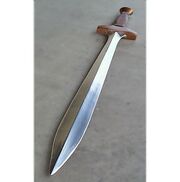
A greek xiphos (unknown).
The last is Dariush's Weapons. Dariush (LG mlf Exp 7; skills: craft (Swordmaking) +11, craft (Elven Steel) +6, craft (glyss) +9, profession (swordsmith) +11) is a lizardman swordsmith that specializes in making swords, pikes, spears, half-spears, quarterstaves, bows, and arrows; and all manner of weapons. He mostly makes swords though. His two brothers Scarr (NG mlf Exp 8; skills: craft (polearms) +11, craft (Staves) +12, craft (maces and clubs) +9, craft (hammers) +6, profession (Weaponsmith) +10) and Zand (LN mlf Exp 6; skills: craft (bows, crossbows, and slings) +10, craft (fletching) +11, profession (bowyer) +9) produce the rest. They each manage five apprentices. The steel that Dariush makes his swords with is a high quality, sharp, strong, flexible steel. The results are often a foot and a half long xiphos (about the size of a broadsword). Dariush also makes dueling swords, and the popular Lizardman sword (falchion). Special commissions for decorations are often produced by the Master himself, who is dedicated and passionate about his craft. Dariush is one of the few smiths that specialize in working elvish steel and glyss.
Scarr and Zand employ lizardman ingenuity to make their weapons. They often produce the full range of weapons that Dariush can't. These include maces, axes, pikes, spears, halberds, most any weapon you can imagine. Zand, however, is a fletcher. He can produce a variety of arrows and bows that heroes need. From sheef arrows for the practical archer, to arrows designed to be put aflame. The three brothers are also notorious for crafting their weapons nearly naked except for aprons or loin cloths for modesty.
The Temple District[]
The Temple District is a district dedicated to the temples of the Hellenic Gods. The temples included are temples dedicated to Ares, Apollo, Zeus, and Athena. Apollo and Zeus' temples have an oracle in residence. An exception to a certain law in the city, the Pythian and Zeusian oracles are consulted regularly. The temple to Ares is an elaborate temple with a large yard to conduct war games. Finally, the temple to Athena has it's famous olive groves.
The Old Town[]
Comprised of the old Pheonician City, Old Town is full of guilds and merchants plying their wares. This place has many tanneries, foundries, textile houses, grain mills, paper mills, brick and shingle makers, potters, bookmakers, woodworkers, carpenters, and other industries. There are also warehouses, stockyards, granaries, coal and charcoal houses, and other storage facilities.
Guilds represented in the city include: the Courtesan Sellers' Guild, the Drapers' Guild, the Goldsmiths' Guild, the Mosaicists' Guild, the Potters' Guild, the Shoemakers' Guild, the Bronzecasters' Guild, the Tavernkeepers' Guild, Silversmiths' guild, the Tanners' Guild, the Weaponsmiths' Guild, the Guild of Armorers, the Fighters' Guild, the Guild of Wizards, the Guild of Glassmakers, and the Crystalworkers' Guild.
With the exception of Hero's Square, the place has a distinct odor that is repellant. In fact, its so pervasive that hardly anyone has a reason to visit, except if you work here. Still, this district sports a few taverns and other businesses catering to the working class. This part of the Hellenic Quadrant has a nasty reputation.
The Ariyan Quadrant[]
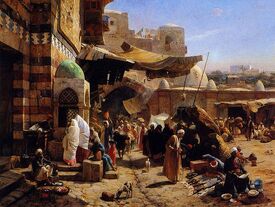
An Ariyan Market (Market at Jaffa by Gustav Bauernfeind (1848-1904) p.d.).
The Ariyan Quadrant is persian themed. The Ariyans wear clothes that cover, from pantaloons, to vests, to shirts, to dresses, to long robes. Long thought to be effeminate by the Greeks, the Ariyans who live here still maintain their old traditions. The place has a few aspects to it. Including Samarkand, the Grand Bazaar, temples dedicated to Azura Masda -- the god of Zarathustra. There are fire temples around the place, and the place seems more exotic to a Hellene. However, this quadrant was built from the few neighborhoods that Alexander, the horned one, didn't burn.
Perhaps the most remarkable part about this Quadrant is the part of the Silk Road that terminates here. The result is a sizable population of men and women that are from the Far East. The Qin'aese here live in Qin'aese Town. The Middle Kingdom themed town is perhaps the most exotic of all towns. Especially with the strangeness of the Qiu family. Ariyan is most often spoken here, but most of the people are bilingual -- being able to speak Hellenic at a moment's notice. There is little crime here, but it's rumored that there is a cell of the Hassassins in this quarter.
Qin'ae Town[]
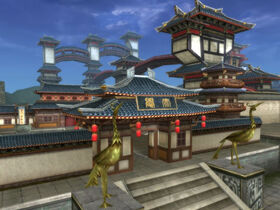
Han Palace in Chang'an (from Cultural China).
Qin'ae Town is where the Qin'aese merchants live. The whole place is like a little Middle Kingdom. With siheyuans and other habitations and apartments done in the Chinese style. However, the oriental deals little in Adventure. But those that do often find themselves in a Western Culture that dazzles them. The Hellenes are sometimes incomprehensible to the average Qin'aese. However, it takes time to adapt.
However some things are not something they can get used to easily. The rampant nudity in the Gymnasia, the frank way of being so truly faced, and the reliance on physics, Euclidean geometry, and engineering; all of this baffles them. The Qin'aese, though, have Feng Shui and they have other mathematics and geometry. They also have their own way of treating disease with herbs and accupuncture. The pharmacology of the Hellenes often grate at them. However, a few Qin'aese philosophers have walked down in the Hellenic quarter and have begun to debate the philosophers of Phaeselis, often at their own game. In this instance, you have a taoist intellectual debating a cynic, and a stoic debates a logician; all in public.
The Vedic Quadrant[]
The Vedic Quadrant is the Southeastern portion of Phaeselis. It's mostly occupied by the Aryavartans, and the city has a strong Indian flavor in Architecture, food, and flavor. The people who live here live a culture that is analogous to the Golden Age of Hinduism. Called vedics by everyone else, the place is as much of a culture shock as Phaeselis itself. The most exotic part of the city, this place is home to a majority of the free Nagaji. The Hindu and Buddhist temples, the Academy of the Way of the Chakras, and the Lotus Blossom neighborhood makes for a beautiful part of the city. Also here, in this quarter, is the illustrious Spice Market.
The Vedics value gold, wealth, beauty, and happiness above all. Their culture seems to blend well with Hellenic culture. The Vedics accept near nudity of both sexes, as their styles attest (the traditional Sari is hardly worn in polite company). However, the Vedics have been accepting Hellenic armor styles in order to conduct war. The Kshatriya caste usually keep their bronze breastplates polished and clean.
The Nagara Temples of Phaeselis[]
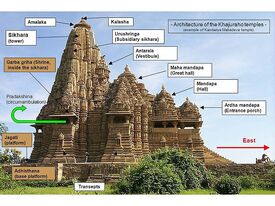
Temple architecture by Tangopaso (CC-by-SA).
The Temples here are constructed after the manner of Nagara temple construction and architecture. They are built in a complex, each temple having the following characteristics:
- In plan, the temple is a square with a number of graduated projections in the middle of each side giving a cruciform shape with a number of re-entrant angles on each side.
- In elevation, a Sikhara, i.e., tower gradually inclines inwards in a convex curve.
The temples here are dedicated to Brahma, Shiva, Vishnu, Kali, Indra, Lakshmi, and Ushas. However, the Polytheistic aspect of Hinduism means that their are many, many gods worshipped by the Vedics and the Nagaji that live in the city. The temples are beautifully wrought out of granite and marble, and the friezes are amazing to behold.
The Phoenician Quadrant[]
In Stark Contrast to the other three is the Phoenician Quadrant, which is the Southwestern Quadrant. The Phoenicians are completely in contrast, since their architecture and style is like the Alexandrian Jews, but influenced by Egyptian and original styles and design. Over the past 50 years, however, many of the Phoenician neighborhoods have become more like the Hellenistic style. The Phoenicians worship one God, but their religion has become steadily more and more stringent over the past three hundred years.
The Quadrant has an industrial district, but controls a vast olive grove. Also, the Olivaen Elven Enclave is located here, along with the headquarters of the Sin Mages. There is no palace, but there is a temple dedicated to their God which holds a passion play four times a year. Also, the quadrant is famous for the city's Necropolis -- where it is said that the dead walk.
The Olive Groves[]
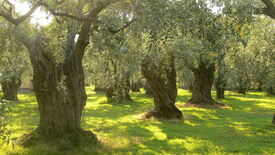
Olive tree grove on Thassos (Petr Pakandl, CC-by-SA).
Phoenician Olives are the best in the land. The olive groves here are the cornerstone to the protection of olive oil, which is used for cooking and lighting. The Phoenicians rely on olive oil, both making it and exporting it. They create volumes of olives to be pressed into olive oil and then they export it to other parts of the world, both east and west.
Phoenician olives in Phaeselis makes up a staple of the diet here. Olives are grown, and picked, and then cured to take the bitterness (caused by oleuropein) out of the olives before they are used in food. The olives produced, and pressed, are of the Spanish type: where they are soaked in lye overnight, and then washed in the morning. Then they are soaked in brine, and this ferments the olive. After fermentation is complete, the olives are packed in fresh brine and sold at market or pressed into oil.
The Necropolis[]
A large plot of land set aside as the graveyard, the necropolis consists of three hills and a Temple to Hades (the Lord of the Underworld and the God of Wealth). The land is vast, and contains two mausoleums and five crypts along with many graves of the dead. The Necropolis is slowly, but steadily, expanding. The area is walled off with several guards posted to warn visitors not to stay after dark because of grave robbers. Most everyone, though, believes in the living dead. They also believe that the living dead wanders the area at night. The cult of Hades and other religious organizations are trying to keep the problem contained.